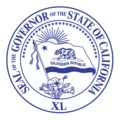| Governor of California | |
|---|---|
 | |
 | |
| Executive branch of the government of California | |
| Type | Chief executive |
| Status | Head of state Head of government |
| Member of | Cabinet Regents of the University of California |
| Residence | Governor's Mansion |
| Seat | California State Capitol (principal workplace) Stanford Mansion (workplace and reception center) |
| Nominator | Political parties |
| Appointer | Popular vote |
| Term length | 4 years, renewable once |
| Constituting instrument | Constitution of California |
| Precursor | |
| Inaugural holder | Peter Hardeman Burnett |
| Formation | December 20, 1849 |
| Succession | Line of succession |
| Deputy | Lieutenant Governor of California |
| Salary | US$224,020 (2022) [1] |
| Website | Official website |
The governor of California is the head of government of the U.S. state of California. The governor is the commander-in-chief of the California National Guard and the California State Guard.
Contents
- Responsibilities
- Gubernatorial elections, oath, and term of office
- Qualifications
- Election and oath of office
- Gubernatorial removal
- Relationship with the lieutenant governor
- Official residence and workplace
- Timeline
- See also
- References
- External links
Established in the Constitution of California, the governor's responsibilities also include submitting the budget, ensuring that state laws are enforced, and making the annual State of the State address to the California State Legislature. The position was created in 1849, the year before California became a state.
The governor is now limited to two terms, regardless of whether they are consecutive. The current governor of California is Democrat Gavin Newsom, who was inaugurated on January 7, 2019. Jerry Brown was the longest serving governor in California history, serving from 1975 until 1983, and again from 2011 until 2019.





